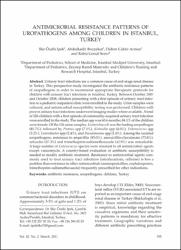| dc.contributor.author | Özahi İpek, İlke | |
| dc.contributor.author | Bozaykut, Abdulkadir | |
| dc.contributor.author | Çaktır Arman, Didem | |
| dc.contributor.author | Sezer Gönül , Rabia | |
| dc.date.accessioned | 10.07.201910:49:13 | |
| dc.date.accessioned | 2019-07-10T19:35:28Z | |
| dc.date.available | 10.07.201910:49:14 | |
| dc.date.available | 2019-07-10T19:35:28Z | |
| dc.date.issued | 2011 | en_US |
| dc.identifier.citation | Özahi İpek, İ., Bozaykut, A., Çaktır Arman, D. ve Sezer Gönül, R. (2011). Antimicrobial resistance patterns of uropathogens among children in Istanbul, Turkey. Southeast Asian Journal of Tropical Medicine and Public Health, 42(2), 355-362. | en_US |
| dc.identifier.issn | 0125-1562 | |
| dc.identifier.uri | https://hdl.handle.net/20.500.12511/792 | |
| dc.description.abstract | Urinary tract infections are a common cause of end-stage renal disease in Turkey. This prospective study investigated the antibiotic resistance patterns of uropathogens in order to recommend appropriate therapeutic protocols for children with urinary tract infections in Istanbul, Turkey. Between October 2007 and October 2008, children presenting with a first episode of urinary tract infection to a pediatric outpatient clinic were enrolled in the study. Urine samples were cultured, and antimicrobial susceptibility testing was performed. Children with proven urinary tract infections underwent imaging studies where available. A total of 126 children with a first episode of community-acquired urinary tract infection were enrolled in the study. The median age was 60.6 months; 84.1% of the children were female. Of the 126 urine samples, Escherichia coli was the leading uropathogen (81.7%), followed by Proteus spp (7.1%), Klebsiella spp (4.0%), Enterococcus spp (3.2%), Enterobacter spp (2.4%), and Pseudomonas spp (1.6%). Among the isolated uropathogens, resistance to ampicillin (85.0%), amoxicillin-clavulanate (73.8%), cefazolin (37.3%) and trimethoprim-sulfamethoxazole (42.9%) was remarkable. A large number of Enterococcus species were resistant to all antimicrobial agents except vancomycin. A country-based evaluation of antibiotic susceptibility is needed to modify antibiotic treatment. Resistance to antimicrobial agents commonly used to treat urinary tract infections (nitrofurantoin, cefixime) is less a problem than resistance to other antimicrobials (aminopenicillins, cephalosporins, trimethoprim-sulfamethoxazole) frequently prescribed for other indications. | en_US |
| dc.language.iso | eng | en_US |
| dc.rights | info:eu-repo/semantics/openAccess | en_US |
| dc.subject | Antibiotic Resistance | en_US |
| dc.subject | Children | en_US |
| dc.subject | Turkey | en_US |
| dc.subject | Uropathogens | en_US |
| dc.title | Antimicrobial resistance patterns of uropathogens among children in Istanbul, Turkey | en_US |
| dc.type | article | en_US |
| dc.relation.ispartof | Southeast Asian Journal of Tropical Medicine and Public Health | en_US |
| dc.department | İstanbul Medipol Üniversitesi, Tıp Fakültesi, Dahili Tıp Bilimleri Bölümü, Çocuk Sağlığı ve Hastalıkları Ana Bilim Dalı | en_US |
| dc.identifier.volume | 42 | en_US |
| dc.identifier.issue | 2 | en_US |
| dc.identifier.startpage | 355 | en_US |
| dc.identifier.endpage | 362 | en_US |
| dc.relation.publicationcategory | Makale - Uluslararası Hakemli Dergi - Kurum Öğretim Elemanı | en_US |
| dc.identifier.wosquality | Q4 | en_US |
| dc.identifier.scopusquality | Q3 | en_US |


















